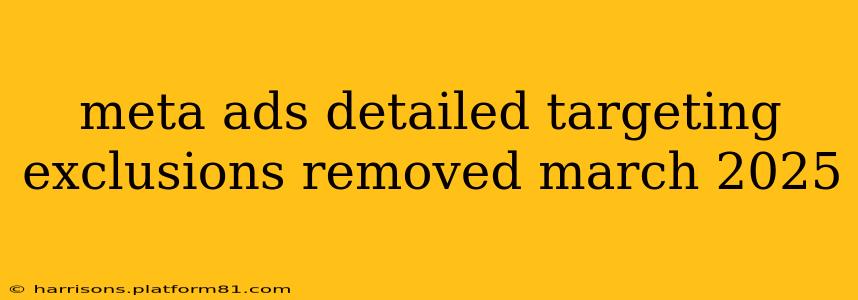The digital advertising landscape is constantly evolving, and Meta (formerly Facebook) is no stranger to significant changes. One such change, the removal of detailed targeting exclusions in March 2025 (hypothetical date for this example, as the actual date may differ), has sent ripples through the marketing community. This article explores the implications of this hypothetical removal, addressing key questions and offering strategies for navigating this new era of Meta advertising.
What are Detailed Targeting Exclusions?
Before diving into the implications of their removal, let's clarify what detailed targeting exclusions are. In simpler terms, these features allowed advertisers to meticulously exclude specific demographics, interests, or behaviors from their ad campaigns. This granular control was crucial for refining targeting, ensuring ads reached the most relevant audience and avoiding wasted ad spend on uninterested users. Marketers used these exclusions to avoid showing ads to groups who were unlikely to convert, protecting their budget and boosting campaign ROI.
Why Did Meta Remove Detailed Targeting Exclusions? (Hypothetical Scenario)
The hypothetical removal of these exclusions is likely driven by a combination of factors. Meta might be aiming to:
- Increase ad revenue: By broadening the potential audience for each ad, Meta could generate more impressions and clicks, leading to higher revenue.
- Simplify the ad platform: Removing complex exclusion settings streamlines the platform, making it potentially easier for advertisers to navigate (though this is debatable given the likely increased complexity in other areas).
- Improve ad relevance (arguably): While counterintuitive, Meta might argue that broadening the audience will expose more users to potentially relevant ads, leading to improved overall ad relevance. This is a complex argument and the actual results might vary considerably.
- Address privacy concerns (indirectly): The move might also be an indirect response to increasing privacy concerns. By reducing the ability to micro-target, they might reduce the potential for discriminatory targeting practices.
What Does This Mean for Advertisers?
The removal of detailed targeting exclusions presents both challenges and opportunities for marketers. On the one hand, it means a loss of precise control over who sees your ads. On the other hand, it forces a shift towards more holistic and creative targeting strategies.
How Can I Still Reach My Target Audience?
This is a critical question for marketers. The key lies in adopting a more sophisticated approach to ad targeting and campaign optimization. Here are some strategies:
- Refine your targeting parameters: While granular exclusions are gone, other targeting options remain. Focus on optimizing your core targeting parameters—interests, demographics, behaviors—to ensure your ads still reach a relevant audience, even if a broader one.
- Leverage lookalike audiences: Lookalike audiences allow you to expand your reach by targeting users similar to your existing customer base. This is a powerful way to find new, highly qualified leads who share characteristics with your most valuable customers.
- Improve ad creative: With a broader audience reach, your ad copy and visuals must be even more compelling. Invest in high-quality creative assets that resonate with a wider range of potential customers.
- Utilize advanced campaign optimization: Employ advanced features like automated bidding and dynamic creative optimization to fine-tune your campaigns and maximize your ROI in the face of broader audience targeting.
- A/B Test Aggressively: Thorough testing becomes paramount. Conduct A/B tests on various aspects of your campaigns to identify what resonates best with the broader audience, continually optimizing for performance.
What are the Potential Negative Impacts of Removing Detailed Targeting Exclusions?
- Increased ad costs: Broader targeting might lead to higher costs per click (CPC) and cost per acquisition (CPA) as ads reach more irrelevant users.
- Lower conversion rates: Without the ability to precisely exclude undesirable audiences, conversion rates might decrease as ads are shown to less qualified leads.
- Increased competition: With a larger pool of advertisers targeting a similar audience, competition for ad space will likely intensify.
What Alternatives Exist to Detailed Targeting Exclusions? (Hypothetical Future Considerations)
Meta might introduce alternative tools or methods to address the concerns raised by the removal of detailed targeting exclusions. This could involve:
- Improved audience modeling: More sophisticated algorithms could help better identify and target highly relevant users, potentially mitigating the impact of lost exclusions.
- Enhanced campaign reporting: Detailed reports providing insights into audience segmentation and campaign performance can help identify which segments are most valuable.
- Contextual targeting advancements: Greater emphasis on contextual targeting, based on website content or app usage, might become a viable alternative.
The hypothetical removal of detailed targeting exclusions in March 2025 (or whenever it may occur) represents a significant shift in the Meta advertising ecosystem. While initially challenging, it also creates an opportunity for marketers to adapt, innovate, and refine their strategies for greater efficiency and impact. By embracing a data-driven approach and staying abreast of new platform developments, marketers can navigate this change successfully and continue to achieve their advertising goals.
